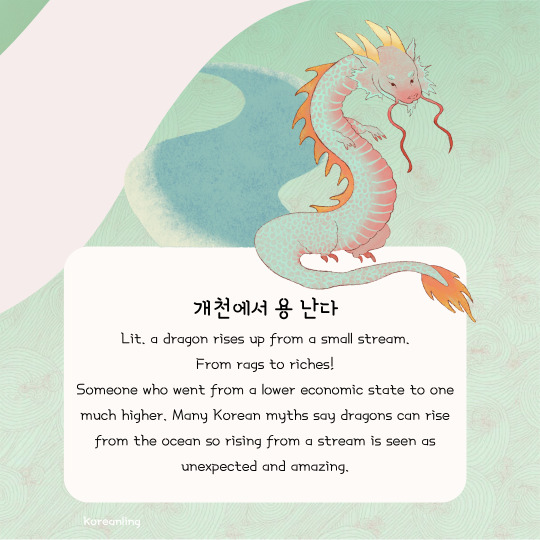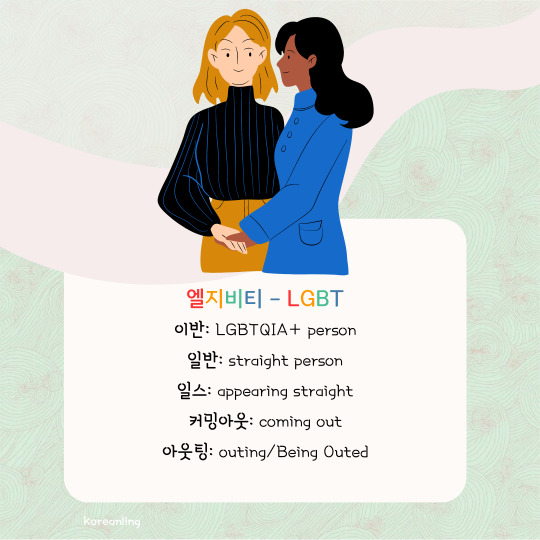kor langblr ;;for my help and yours;; koreanling.com
Last active 4 hours ago
Don't wanna be here? Send us removal request.
Text
놀고 먹다

놀다: to play/hangout 먹다: to eat
놀다 + 먹다 combined together means “to live idly/without purpose”. Living an easy comfortable life without a job or work, just playing and eating your life away haha
그냥 놀고 먹고 싶어요: I want to just live idly
11 notes
·
View notes
Text

Korean MBTI Terms:
잇프제: ISFJ 잇프피: ISFP 잇티제: ISTJ 잇팁: ISTP 인티제: INTJ 인팁: INTP 인프제: INFJ 인프피: INFP 엣프제: ESFJ 엣프피: ESFP 엣티제: ESTJ 엣팁: ESTP 엔티제: ENTJ 엔팁: ENTP 엔프제: ENFJ 엔프피: ENFP
#korean#korean langblr#korean studyblr#vocab#langblr#studyblr#mine#korean vocab#korean culture#culture
10 notes
·
View notes
Text
Korean Prepositions

위: on/above 안: in 속: inside, among
밖: outside 밑: under/beneath 아래: under/beneath 앞: in front 뒤: behind
왼쪽: left 오른쪽: right
건너편: across from
사이: between 가운데:in the middle 옆: next to 근처: near
한국어 교과서는 책상 위에 있어요: The Korean textbook is on the desk 그의 강아지는 소파 아래에 있어요: His puppy is under the sofa 고양이는 제 서랍 안에 숨어 있었어요: The cat was hiding in my drawer
#korean#korean langblr#korean studyblr#langblr#studyblr#grammar#korean vocab#mine#vocab#korean grammar
69 notes
·
View notes
Text
5 Different Ways to Say What in Korean
‘What’ is always a keyword in a language, and important to growing your vocab and skills but there are actually multiple ways to say ‘What’ in Korean! Which one you use depends on the information and the words’ location in a sentence.

1. 무엇/뭐
뭐 and 무엇 are probably the ‘What’ you’ll hear the most when starting to learn Korean. But 뭐 is a shortened version and casual form of 무엇. 무엇/뭐 can be used when the subject is unidentified, and should not be used in front of nouns. So for example you cant say “뭐 노래”.
Examples of 무엇/뭐:
이거 뭐 예요?: What is this? 이름이 뭐예요?: What’s your name?
2. 어떤
어떤 comes from 어떻다 and can be used for questions about both objects and people. It’s used more when you want more information or to specify; from a name, type/genre, description, and more. It’s similar to asking “What kind of —?” where the possible answers are more limited and specific.
Examples for 어떤:
어떤 영화를 보고 싶어요?: What type of movie do you want to watch? 어떤 노래를 좋아해요?: what kind of songs do you like?
3. 무슨
무슨 is similar to 어떤 and is used before a noun in a question. 무슨 is used for clarification, typically when you don’t have an idea. Compared to ��떤, the options for the answer are more limited.
When to use 무슨:
무슨 생각해?: What are you thinking about? 무슨 노래를 좋아해요?: What song do you like?
So you can see in my examples for “— 노래를 좋아해요” adding 무슨 vs 어떤 has different nuances to it! If you compare “— 영화를 보고 싶어요” adding 무슨 has the meaning more directly asking for a movie title, while 어떤 is asking for a genre or type of movie.
4. 어느
어느 mostly means which but is used to mean ‘What’ in Korean as well. If you’re using 어느 you already have options in mind and are asking between them.
어느 Usage Examples:
어느 나라 사람이에요?: What country are you from? (Which country person are you?) 어느 색깔이 더 좋으세요: Which color do you like better?
5. 몇
Finally, 몇 is just used with numbers and counting. While it doesn’t always mean ‘What’ in Korean, it’s used like ‘What’ in certain cases.
Examples for 몇:
몇 시가 가장 좋으세요?: What time works best for you? 지금 몇 시예요?: What time is it? 몇 분이세요?: How many people? (for example: it’s used a lot at restaurants, asking how many people in your group)
28 notes
·
View notes
Text
Korean Summer Vocab - Activities and Locations

산: mountain 계곡: valley 등산: hiking 캠핑: camping 글램핑: glamping (glam camping, camping with modern tech and comforts) 소풍을 하다: have a picnic 바베큐를 하다: to barbeque

한강: Han River 바다: sea 호수: Lake 해변/바닷가: seaside/beach (same meaning, just 해변 is Sino-Korean and 바닷가 is a native Korean word) 수영장: pool 수영하다: to swim 물놀이: playing in the water 요트를 타다: to go sailing (lit. to ride/get on a yacht) 파도타기를 하다: to surf 비치발리볼: beach volleyball 인명 구조원: lifeguard 모래: sand 모래성: sandcastle
15 notes
·
View notes
Text
Summer Weather Vocab!

계절: seasons 여름: summer
여름일: summer job 여름 방학: summer vacation from school 휴가: vacation from work 여행: travel/trip 휴식: rest
더위: heat 폭염: Heatwave 온도: temperature 습도: humidity 해/태양: sun 햇빛: sunlight 땀: sweat 선크림: sunscreen 자외선 차단 지수: UV index (SPF factor) 선풍기: fan 에어컨: AC/Air conditioner
햇빛에 타다: to get a sunburn 선탠을 하다: to get a tan 덥다: to be hot 습하다: to be humid 화창하다: to be sunny 따뜻하다: to be warm
소나기: sudden shower 비: rain 장마: rainy season 우산: umbrella
19 notes
·
View notes
Text
Learn Korean with Korean Children’s Shows
Many children’s media is easily accessible too, with a lot of shows officially uploaded to YouTube for free so you don’t have to hunt down resources or pay for a specific subscription or platform. They are great for beginner practice because of the easy-to-follow plots, simple dialogue, and story!

Hello Jadoo – 안녕자두야 The plot focuses on a young girl in Seoul and her antics with friends and family.
The Youtube channel Learn Korean with Jadoo is a good resource, with both Korean and English subtitles (with subtitle options for more languages too!) in short 10min episodes.
Pororo the Little Penguin – 뽀롱뽀롱 뽀로로 The most popular recent Korean children’s TV show, Pororo has hour-long episodes uploaded to YouTube for free as well; but the official channel doesn’t come with English or Korean subs so keep that in mind.
Dooly the Little Dinosaur – 아기공룡 둘리 A late 80s to 90s Korean kids’ TV show, Dooly is also an official South Korean citizen
Anpanman – 안판만 Popular children’s show about a bread superhero, it’s Japanese but still big in Korea (and dubbed in Korean), also referenced in the iconic BTS song
Pinkfong 핑크퐁 No doubt you probably know “Baby Shark”, which craze was started by the Pinkfong channel originally in Korean and then into English. They have a bunch of Korean songs and short stories on their channel.
JunyTony 주니토니 Channel about animated twin wizards with animal friends, who go on magical and musical adventures, using their spells to save the day.
yearimTV 예림TV This YouTube channel has many short stories and songs like the others, but also has a focus on traditional Korean stories.
#thanks for adding on!#theres a ton of korean shows out there for learners to use~#its nice cuz you can find something that fits your interests or level too
147 notes
·
View notes
Text
SINO KOREAN NUMBERS (pt.2)
Hello! As promise, second part is here!
Telephone numbers (05860791834)
Metro/Bus lines (Line 8 / Bus 576)
Height/Weight (150cm and 50kg)
Years (2024, 2000, etc)
Minutes and seconds (45min and 20 seconds)
Prices (5,000 wons)
Directions (Sherman, 42 Wallaby Way, Sydney)
HOW TO SAY PHONE NUMBERS:
Let's take ( 05860791834 ) as our example.
You have to say number by number: 0-5-8-6-0-7-9-1-8-3-4
공(0) / 오(5) / 팔(8) / 육(6) / 공(0) / 칠(7) / 구(9) / 일(1) / 팔(8) / 삼(3) / 사(4)
For zero, you can say both (영/공)
HOW TO SAY METRO/BUS LINES:
Line 8 / Bus 576 = 팔번 / 오백칠십육번
We will use "번" to say "line".
HOW TO SAY KILOS/CM:
150cm and 50kg = 백오십센치 / 오십킬로
We use: 센치 for height and 킬로 for weight.
HOW TO SAY THE YEARS:
To say year we will use 년, for example:
Year 2022 = 이천이십이 년
HOW TO SAY MINUTES AND SECONDS:
For minutes, we will use 분 and for seconds we will use 초. For example:
45 minutes / 30 seconds = 사십오 분 // 삼십 초
HOW TO SAY PRICES:
30€ (euros) = 삼십 유로
4,000 ₩ (wons) = 사촌 원
56$ (dollars) = 오십육 달러
HOW TO SAY DIRECTIONS:
It's the same as before, if you live in house number 40, you will say "사십".
67 notes
·
View notes
Text
Fruits & Veggies in Korean

Fruits in Korean
딸기: strawberries 사과: apples 블루베리: blueberries 포도: grapes 체리: cherries 복숭아: peaches 라즈베리: raspberries 블랙베리: blackberries 토마토: tomatoes 오이: cucumbers 멜론: melons 수박: watermelon

Vegetables in Korean
상추: lettuce 당근들: carrots 무: radish 시금치: spinach 고추: chili 비트: beetroot 완두류: peas 양파: onion 케일: kale 감자: potato 대황: rhubarb 마늘: garlic

Herbs in Korean
허브: herb 바질: basil 민트: mint 부추: chives 로즈메리: rosemary 오레가노: oregano 현자의: sage 파슬리: parsley 백리향: thyme 딜: dill 고수: cilantro
108 notes
·
View notes
Text
Flowers in Korean Vocab

들꽃: wildflowers 꽃잎: petal 꽃의 꿀: nectar 꽃가루: pollen
장미: roses 동백꽃: camellia 난초: orchid 튤립: tulip 진달래: azalea 백합: lily 연꽃: lotus 나팔꽃: morning glory 해바라기: sunflower 수선화: daffodil
53 notes
·
View notes
Text
How to say not with ~하다 verbs
For most verbs when you want to say “I don’t xx” or “I didn’t xx” you put 안 before the verb like so “밥 안 먹었어요” (I haven’t eaten). But verbs that use ~하다 are a combination of a word plus the 하다 (to do) verb. When you are using those words you need to put 안 in between 공부-하다 to make a sentence like “오늘 공부 안 했어요” (I didn’t study today)
example ~하다 verbs:
운동하다: to exercise (운동 + 하다)
일하다: to work
공부하다: to study
집중하다: to concentrate
걱정하다: to worry
노래하다: to sing
등산하다: to hike
사랑하다: to love
성공하다: to succeed
수영하다: to swim
연습하다: to practice
인사하다: to greet
질문하다: to ask a question
There are a bunch of ~하다 verbs so keep this point in mind!
오늘 공부 안 했어요: I didn't study today 노래방에서 노래 안 했어요: I didn't sing at karaoke 그사람 함께 일 안해요: that person doesn't work with me 왜 아무도 집중 안해요?: Why isn't anyone concentrating?

45 notes
·
View notes
Text

서울에서 김서방 찾��
Lit. Like trying to find Mr. Kim in Seoul Like trying to find a needle in a haystack. Something too hard to try to find. Because Kim is the most popular surname in Korea and in Seoul there would be countless Mr. Kim’s.
#korean#korean langblr#vocab#korean studyblr#langblr#culture#studyblr#korean expressions#idioms#mine
8 notes
·
View notes
Text

개천에서 용 난다
Lit. a dragon rises up from a small stream. From rags to riches! Someone who went from a lower economic state to one much higher. Many Korean myths say dragons can rise from the ocean so rising from a stream is seen as unexpected and amazing.
#korean#korean langblr#korean studyblr#vocab#langblr#studyblr#culture#korean expressions#idioms#languages#linguistics#mine
18 notes
·
View notes
Text
~ㄹ/을 거예요 Korean Future Tense Rules
The rules are really simple! Like other particles you may have reviewed and studied, such as 을/를, the beginning is determined by the verb before and if it’s a consonant or vowel.
When the verb (without the dictionary 다 added at the end; so just 가 for 가다 for example) ends with a vowel then you add ~ㄹ 거예요; so 갈 거예요. Meanwhile, when it ends with a consonant you add ~을 거예요 at the end. Let’s get into some quick examples:
Ending in a vowel:
가다: to go 갈 거예요: going to go 만나다: to meet 만날 거예요: going to meet 공부하다: to study 공부할 거예요: going to study
Ending in a consonant:
입다: to wear 입을 거예요: going to wear 먹다: to eat 먹을 거예요: going to eat
One last thing; if the verb already ends with a ㄹ, skip adding ~ㄹ/을 and just add -거예요. So here are some examples of that:
살다: to live 살 거예요: going to live 팔다: to sell 팔 거예요: going to sell 놀다: to play 놀 거예요: going to play
So now here are some quick example sentences to help you get a feel for how to use Korean future tense!
언니는 꼭 열심히 공부할 거예요: My older sister will study really hard 다음 주말에 뭐 할 거예요?: What are you going to do next weekend? 금요일에 쇼핑할 거예요: I’m going shopping on Friday 친구 집에서 놀 거예요: I’m going to play/hangout at my friends’ house 프랑켄슈타인은 괴물의 살 거예요!: Frankenstein’s monster will live!

~ㄹ/을 거예요 VS ~ㄹ/을게요
Another option for Korean future tense is ~ㄹ/을게요 which has a more specific meaning. This particle has the feeling like you are checking if something is okay with the listener without outright making it a question. ~ㄹ/을게요 is used more when you want to be less blunt, it could be directly involved with the listener or not but it must be in first person with you doing the action.
Kind of like this:
금요일에 쇼핑할 거예요: I’m going shopping on Friday 금요일에 쇼핑할게요: I’ll go shopping on Friday (if that’s okay)
Here are some more examples using ~ㄹ/을게요:
이제 밥을 먹을게요: I will eat now 제가 식료품을 가져올게요: I will get the groceries 나중에 전화 할게요: I will call you later
One common use is putting ~ㄹ/을게요 with 그렇다 (correct/that’s right) to make 그럴게요 which gives a softer agreement; kind of like “Okay, I’ll do that” or “I’ll do it if you want”.

10 notes
·
View notes
Text
Happy Pride! Let’s look at some Korean LGBT+ Terms

엘지비티: LGBT 레즈비언: Lesbian 게이: Gay 양성애: Bisexual 트랜스젠더 (or 트렌스): Transgender 퀴어: Queer 인터섹스: Intersex 무성애자: Asexual 퀘스처닝: Questioning 범성애자: Pansexual 얼라이: Ally 바이젠더: Bigender 에이젠더: Agender 논바이너리: Nonbinary 이성애: Straight
트랜스여성: Trans woman 트랜스남성: Trans man 씨스젠더: Cisgender

Some Quick LGBT Slang
이반: LGBTQIA+ person (이반인 “abnormal people” – note: not derogatory lgbt claimed this themselves) 일반: straight person (일반인 “normal people”) 일스: appearing straight (short for “일반 스타일 “normal style”) 커밍아웃: coming out 아웃팅: outing/being outed – someone exposes you and forces you out
123 notes
·
View notes
Text
WORD OF THE DAY.
Hello, hello!
Today, our word of the day, it's a word made up of four words.
생년월일 = date of birth.
So, lets descompose our word.
생(일) = birthday.
년 = year.
월 = month.
일 = day.
So, in other words... You can say, korean said "date of birth" as birthday year month day, they took it very literal... And i think it's funny!
18 notes
·
View notes
Text
K-Pop Breakdown: "흐린 가을 하늘에 편지를 써" by 김광석
여러분 안녕하세요! I recently got a request to breakdown this song, so here it finally is! You can find the Korean lyrics and listen to the song here, and I also referred to this page and Naver Dictionary to help me out with the English translations.
Vocabulary
비가 내리다 = to rain; rain falls
둘러싸다 = surround; encircle
숨결 = breath
떨치다 = to shake off; to break free from
잊혀지다 = to be forgotten
접어놓다 = to put away
창문 = Window
흐리다 = overcast; murky; cloudy
가을 = autumn
편지를 쓰다 = to write a letter
바람이 불다 = wind blows
유혹하다 = to entice; to lure
Grammar
비가 내리면 음… 나를 둘러싸는 / 시간의 숨결이 떨쳐질까?
When it rains... will I break free from the breath of time that surrounds me?
-(으)면: If/When
Attach this to a verb stem to mean "if/when [verb]." 비가 내리면 means "if/when it rains."
-는
When attached to a verb stem, -는 turns a verb into its present-tense noun-modifying form. In other words, it allows you to describe nouns using verbs, like the way we use the word "that" in English. 나를 둘러싸는 시간의 숨결 means "the breath of the time that surrounds me." 둘러싸다 describes the noun, 시간의 숨결.
-(으)ㄹ까
This structure has a couple of different meanings, but in this case, it is used essentially to wonder out loud. The speaker is asking if he will break free from what entraps him.
난 책을 접어놓으며 창문을 열어 / 흐린 가을 하늘에 편지를 써 / 음…잊혀져간 꿈들을 다시 만나고 파
I set aside my book and open the window / I write a letter in the cloudy autumn sky...I want to meet the forgotten dreams again.
-(으)며
This structure is one way to say "and," although it can be translated differently as well. It can mean "while," as in, "while putting aside my book I open the window" too.
-고 파
This is a shortened version of -고 싶다, which means "to want [to do something]." 만나고 파 means "I want to meet [someone/something]."
That's about it for this breakdown--thanks for reading and thanks to the anon for your patience with this request! Check out my other breakdowns here and feel free to request any other song that I haven't done yet! See you in the next lesson! 화이팅!
My masterlist
Join my Discord chat here to practice Korean with others!
Follow me on Instagram here for more Korean content!
Check out my Ko-Fi to support this blog and my studies! Thank you for your generosity!
74 notes
·
View notes